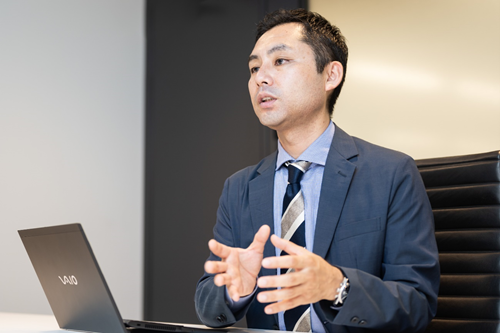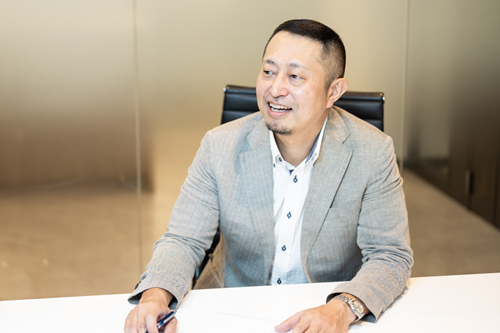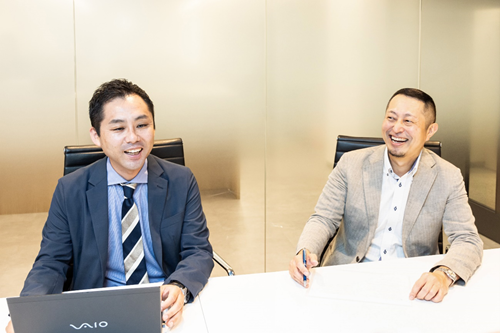
At TIS INTEC Group, we engage in CVC (Corporate Venture Capital) by making principal investments with our own funds rather than through fundraising activities. In our CVC activities, we strive to achieve growth in collaboration with startup companies in the industries and IT domains that TIS INTEC Group is engaged in. MEEQ, one of the companies TIS-CVC will invest in, is developing a Mobile Virtual Network Enabler (MVNE) business as well as an IoT platform business by leveraging its ability to deploy triple-carrier connectivity (NTT Docomo, Softbank, and KDDI). We spoke with Mr. Katsunori Yamagishi, who leads CVC activities at TIS, and Mr. Ryuta Minemura, Founder, President, and Representative Director of MEEQ, to learn about how the two companies came together, their strengths, and what kind of future they hope to create through their collaboration.
The MVNE business is the “behind the scenes” engine of MVNOs, which provide low-cost communication services for smartphones, also known as “low-cost smartphones” and “low-cost SIMs.”
Because we provide the user communication lines, billing, and other services, MVNOs are able to launch their low-cost SIM business as soon as they have their brand and sales structure in place. This business started in April 2013, when I was working for Sony Network Communications before starting the company, and we have already helped many MVNOs. One of the most unique features of our MVNE business is the ability to use data communication SIMs with voice and SMS functions and data communication-only SIMs through the triple carrier lines of NTT Docomo, Softbank, and KDDI.

Later, as the adoption of DX accelerated among many companies and organizations, we launched the MEEQ platform in response to the rapidly expanding needs of the IoT (Internet of Things). The MEEQ platform supports triple carrier data-only SIMs and allows users to purchase and manage multiple IoT lines from an intuitive GUI web console screen, thereby eliminating the need to set up a system themselves. Orders, cancellations, and plan changes can be easily completed on the MEEQ Console, and SIMs can be purchased from a single SIM, making communication lines easy to use and ideal for new businesses and PoC (proof-of-concept) environments.
We also offer a “MEEQ Data Platform” for data accumulation and “MEEQ AI” for data utilization, providing a one-stop solution for functions required for IoT and DX.
IoT applications are often used in the shadows of buildings, mountainous areas, coastal areas, and other areas where some carriers’ signals do not reach. The MEEQ platform has a significant advantage in this regard because it covers the lines of all three carriers, allowing users to freely select the line that best fits their needs.
Another advantage of MEEQ is that it can combine the lines of the triple carriers to form a closed network, or in other words, a secure communication environment. Unlike Wi-Fi and other internet environments, MEEQ provides a secure communications environment, making it ideal for handling sensitive data.
The secret lies in the two-way development with the MVNE business. The fact is that the usage patterns of smartphone users are predominantly download traffic, including video browsing, while upload traffic is rarely used. In contrast, the vast majority of IoT applications involve uploading data collected by individual devices, such as surveillance cameras. In other words, the MEEQ platform’s MEEQ’s efficient use of available bandwidth in the MVNE business allows us to offer optimal plans and pricing structures to meet the needs of our customers.

In addition to this plan design, triple-carrier support, as well as the aforementioned ease of operation with a one-stop solution for features required for IoT and DX without the need for software development, MEEQ’s unique features enable it to meet a wide range of needs, including the ability to build closed networks either in the cloud or on-premises and global SIM compatibility that can be used in some 182 countries and regions, making it possible to expand the IoT business overseas. This has led to MEEQ acquiring a diverse customer base across industries and business categories, and the number of customers is increasing on a daily basis, with approximately 8,000 companies using the service in the three and a half years since its launch.
As a recent development, we established a new service category, “MEEQ Business Tools,” which provides the business support services needed to operate IoT services, and we started to provide “MEEQ Business Tools SMS Sending” as the first service on July 2, 2024.

After working for a telecom startup, I joined So-net Entertainment (now Sony Network Communications) in 2011, where I was involved in launching NURO and MVNE businesses. Then, in 2019, we founded MEEQ (Sony Network Communications Smart Platform at the time) to compete in the IoT platform market by leveraging the mobile network and capabilities we developed in the MVNE business.

Both our companies had been looking for points of synergy for collaboration since last year, but MEEQ’s low-cost secure telecom service with triple carrier coverage was that one thing that really caught our attention and made us say, “This is it!” The primary factors in our decision to invest were the established technology and its successes, the company’s direction and business-building capabilities, and the corporate culture, all of which seemed to be a good fit for our company. And by investing in MEEQ, we hope to increase collaborative opportunities for both companies and create a situation that benefits both. Since the investment is recent, we are currently discussing collaborative possibilities with several of our group companies. We aim to tap into each company’s strengths and expand opportunities to collaborate in ways that benefit both parties.
The IoT market has grown rapidly since the MEEQ project was launched in 2021. Our strengths are in telecom-related fields, so collaborating with TIS, which has extensive knowledge of a wide range of industries outside of telecom, is critical to better translating those strengths into growth. Working with them gives us great comfort because needs are always growing, regardless of industry or business type. I think that TIS-CVC plays an important role in helping us to continue and deepen our relationship with TIS. We are also grateful for the support that goes beyond our original expectations, such as the ability to communicate externally through TIS-CVC.
The investment decision process was rational, and the deliberation phase was short, so we were quite impressed by the breadth and depth of TIS’s understanding of startups.
Thank you very much. We try to keep the investment deliberation phase as short as possible to avoid placing an undue burden on the startup and also to avoid missing out on business opportunities, so it’s great to hear that these efforts were appreciated. We are also pleased that TIS-CVC was recognized for its role as a bridge between startups and TIS, which is an important part of CVC operations.

Looking at the TIS website, I see that their long-term strategy for the next decade or so is to solve social problems through collaborative efforts with partners. That’s exactly the same kind of contribution that we want to make.
We very much look forward to working with you. We are committed to maintaining a positive, collaborative relationship with our portfolio companies, including MEEQ, and using it as the basis for our mutual success.
As we say in our TV commercials, at TIS INTEC Group, we are dedicated to ” Through the power of IT, the TIS INTEC Group will continue to make society’s wishes come true. and we want to grow alongside promising startup companies that contribute to solving the challenges faced by society.